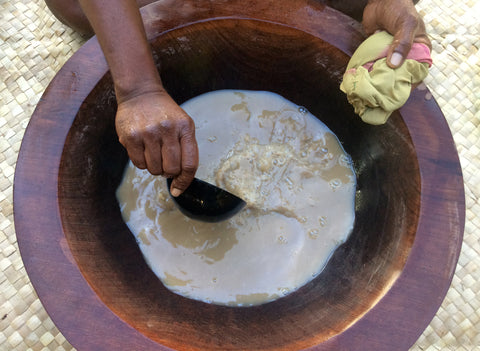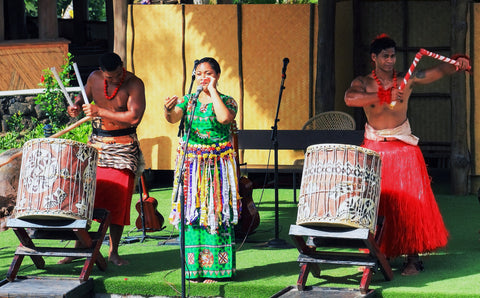
Kava has significance in each region of the Pacific Islands. What it means in Hawaii may be different than what it means in Fiji. Tongan culture is rich in history and kava has a deep-rooted importance to the people living on these islands.
Tongan Culture and Traditions
Tonga is composed of 150 islands. Most of the islands are not inhabited and remain wild with coral beaches, volcanoes and palm trees.
Farming and fishing are how Tongans make money. Fruits and vegetables and roots of plants are harvested for export. Many of the women also create products from natural items found in Tonga including woven baskets and mats.
Men build canoes and create art from wood to supplement incomes. They also make jewelry from shells, and textile arts using natural materials.
It is believed people arrived there from Fiji. The Tongan islands have been inhabited for over three thousand years. And for just as long, there has been Tongan culture and customs established that still exist today.
Food and Drink Customs in Tonga
People eat, and drink freely but also use them for special gatherings with family and friends. Ceremonies on the island are special occasions where the traditional drink of kava is offered to men. Women typically only serve kava.
While many drink kava daily throughout the Tongan villages, it is served for many reasons. Reasons include marriages, coronations of leaders, and funerals. Kava holds a special place in Tongan culture.
Drinking kava in Tonga is compared to men in the United States drinking beer at a bar. It is true that many Western habits and traditions have filtrated the Tongan Islands, including the drinking of alcohol. However, kava still holds higher importance within the Tongan culture, especially in the way it is prepared.

Kava Preparation in Tonga
Kava is harvested from the root of the Tongan plant called piper methysticum, which is a relative of the pepper plant. In ancient times, the kava root was cut into small pieces and chewed. The juice the chewing of the root created was spit into a bowl. The spit was consumed by Tongans to receive its calming effects.
Fortunately, today, kava is prepared in a healthier manner.
The root is pounded into powder form. The powder is then mixed with water. A female member of the village called a tou’a, is usually the one who will mix kava and serve it.
The water mixed with kava is strained through a porous cloth. The strained mixture is what is served to the males in the village in a specific order, starting with the leaders first.
On the main island of Tonga, kava is usually saved for drinking on Wednesday and Saturday nights. But on the outer islands, kava is prepared and consumed every night of the week.
Effects of Tongan Kava
Kava has an intoxicating effect without interrupting mental clarity. It is used in Tonga to relax the body and give people a feeling of good will towards others.
Kava strength is chosen by its color during the mixing process. After many years of drinking, the tou’a know the right color of kava for the right effects. A numbing of the tongue is reported to happen soon after drinking kava.
Other effects of kava can include helping a person get a good night’s sleep. Some drink it to be sociable, while others drink it to de-stress after a hard day’s work. Furthermore, Tongans have used kava as a sedative, muscle relaxants, diuretics and for nervousness.
Kava is consumed from the traditional Tongan kava bowl.
Tongan Kava Bowl
You would think a bowl that is used to hold a drink of great cultural importance would be ornate and fragile. Not the kava bowl. Although it is of great cultural significance, it is quite humble in appearance. Often, kava is consumed in coconut shells or cups.
Traditional kava bowls are made of wood and have four legs. It is placed on the ground for stability when the tou’a is mixing kava for drinking.
These methods of mixing and drinking kava continue today in both ceremonies and in the clubs established all over the islands.

Tongan Kava Clubs
Bonding among men is important to the Tongan culture. The use of kava helps people bond due to its relaxing and mind opening effects.
In some villages, kava is consumed every night by local men. In Tongan kava clubs, or kalapus, or faikava, men gather to enjoy kava at the end of the day. The tou’a cannot be related to anyone in the clubs today. However, in traditional Tonga, the tou’a was a female who was engaged to one of the villagers in the kava ceremony.
Kava drinkers sit in a circle and pass the kava by hand from the inner circle to the farthest out. Men discuss everything from sports to politics between rounds of kava drinking. Kava allows the men to be open and honest and accepting of other’s opinions, even if they do not agree with their own.
Tongan Kava Legend
Legend has it parents of a leprous daughter whose name was “kava”, sacrificed her to the ancient sacred king. After she was buried, two plants began to grow on her grave, piper methysticum and sugar cane. Since this time, both plants are used in important ceremonies and rituals.
This act corresponds with the four virtues of the Tongan culture. The four virtues include respect, humility, commitment and keeping good relations.
These four virtues still exist today. They are expressed as mutual respect; sharing, cooperating and fulfillment of mutual obligations; humility and generosity; and loyalty and commitment.
Tonga’s use of kava enhances these virtues. When you drink kava, you are expected to share with each other. Kava opens the mind to good will towards others, enabling the virtue of mutual respect. Kava also makes you feel generous. It also helps you feel humble and gracious for fellow men.
Kava, because of its great benefits, should be important in all cultures, not just Tongan. We could learn a lot from the Tongan culture.
